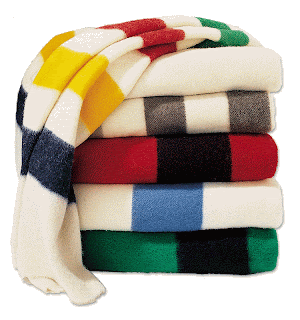 |
| New colour and sizes were added as style changed but the original colours with points remain part of the collection . photo from http://www.nativecanadian.ca/ |
One point= one made beaver (fully dressed)
From 1670 until 1805 , the HBC Point blankets were woven by hand at the Witney Mills in Oxfordshire , England by various local companies . Eventually all wool mills standardized their mills to the standards expected by the HBC for trade in North America . Those expectations were determine by the popularity among Aboriginal peoples with whom the HBC traded . The size of the blanket was indicated by a number of points sewn into one side of the blanket . The blankets at the Height of the fur trade ranged from 1 to 4 and included half points , 4 being the largest .
Metis and French Canadians who worked as voyageurs adopted the HBC Point blanket which was made into a hooded coat called a capote . Each area from which these voyageurs came was represented by a particular colour : Red with black stripe- Quebec ; Blue with black stripe- Montreal ; multi stripe on any background- Trois Rivieres . Aboriginal People preferred the white blanket with multi colour / black stripe . This type made good camouflage in the winter hunt .
These blankets were and still represent 'Canadian' across the world having been a part of it's history for over 340 years . There is nothing like a warm Hudson Bay Blanket for cold Canadian winters .
Check out these sites for more on the story of Point Blankets:
http://www.blanketstory.org.uk/
http://www.nativecanadian.ca/


No comments:
Post a Comment